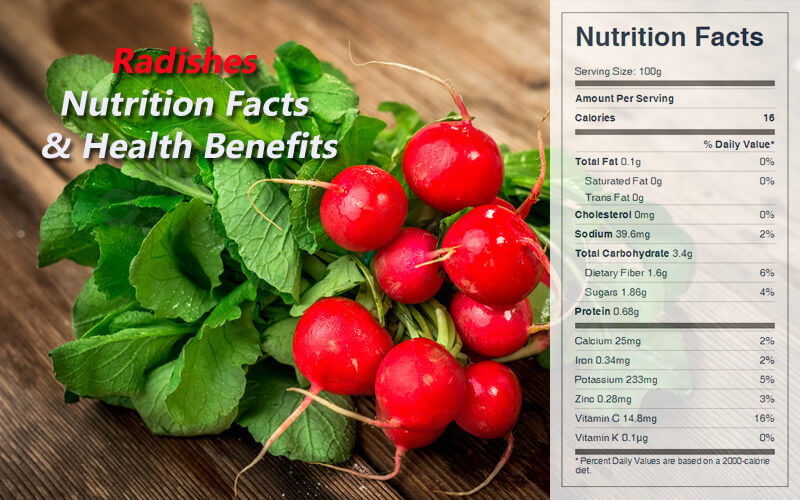Radishes Nutrition Facts & Health Benefits
The radish is a root vegetable belong to the crucifer family and are valuable for those at risk from cancer. Radishes contain other nutrients, including plenty of potassium, calcium, and sulfur, as well as vitamin C and vitamin B-complex.
Radishes are grown throughout the world, being mostly eaten raw as a crunchy salad vegetable with a pungent flavor. Radishes owe their sharp flavor to the various chemical compounds produced by the plants, including glucosinolate, polyphenols, and isothiocyanate.

Nutritional value of Radishes
A raw radish is 95% water, 3% carbohydrates, 1% protein, and has negligible fat.
In a 100-gram reference serving, raw radishes provide 16 kcal of food energy and have a moderate amount of vitamin C (18% of Daily Value), with other essential nutrients in low content.
Ten medium raw summer radishes provide 8 calories, 1.6 g carbohydrate, 0.3 g protein, 0.2 g fat, 0.7 g dietary fiber, 4 IU vitamin A, 10 mg vitamin C, 12 mcg folic acid, 104 mg potassium, 11 mg sodium, 8 mg phosphorus, 9 mg calcium, and 4 mg magnesium.
Raw Radish Nutrition Facts Label
Health Benefits of Radishes
The roots and leaves of radishes consist of vital nutritional value and bioactive compounds with antioxidant properties. The leaves have higher levels of proteins, calcium, and ascorbic acid; they also have twice the total polyphenols and four times the flavonoids than found in the root. The significant number of flavonoids translates to significant antioxidant potential. Their tops should be eaten at the same time, as this aids the digestion of the vegetable.
In ancient times, radishes were used medicinally to treat stomach disorders, hepatic inflammation (hepatitis), and heart problems. Radishes can helpful to our liver and a great tool to help regulate glucose, prevent oxidative stress caused by diabetes, and balance glucose uptake and absorption. Bioactive compounds found in radish root have shown to decrease the severity of fatty liver disease in animal studies. With a growing trend in fatty liver disease, again due to our inflammatory dietary lifestyle, adding radish among other plants can help reverse this condition. The mechanism of action by which radish affects our liver is in its ability to upregulate the expression of various liver enzymes, reduce oxidative stress, and regulate inflammation.
Radish juice acts powerfully on the gallbladder, stimulating the discharge of bile.
The radish is high in glucosinolates, which are recognized for their anti-inflammatory potential. Studies have found elevated levels of pyrogallol and vanillic acid in the radish roots, whereas the leaves consisted of high levels of epicatechin and coumaric acid. Studies also attributed the antioxidant potential in radishes to be due to the higher levels of anthocyanins.
Radishes can also help regulate blood sugar, enhance the synthesis of adiponectin. Adiponectin is a protein hormone involved in regulating lipid and glucose metabolism. It increases insulin sensitivity and helps with weight loss through its key mechanisms, but adding polyphenols such as catechin also helps improve insulin secretion.
Radish greens are said to have six times the vitamin C of the roots, and they provide calcium as well. The Oriental radish, also known as daikon, is a larger, winter radish. It is also a good source of vitamin C.
As with the other cruciferous vegetables, radishes contain compounds that show potential for fighting cancer. Daikon also contains an enzyme called myrosinase that is believed to help in digestion and that, in the presence of water, converts to thiocyanates and isothiocyanates, some of which may be involved in the radish’s anti-cancer benefits.